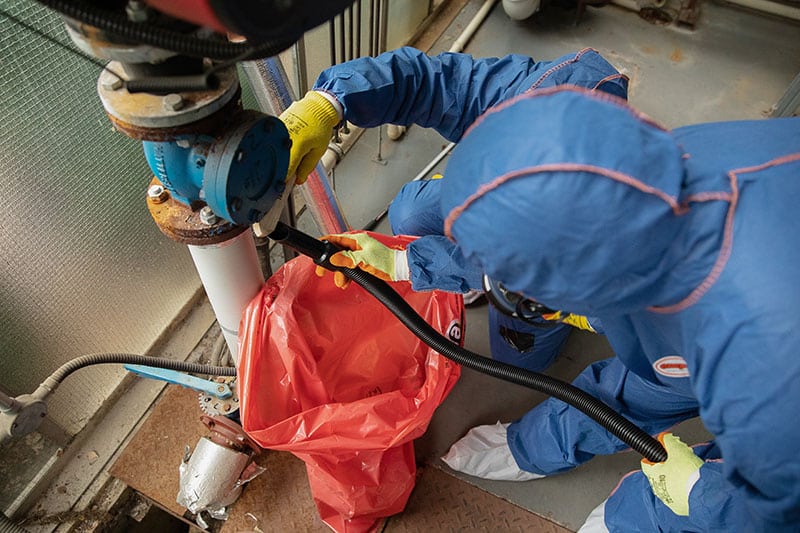Asbestos Removal – What should loss adjusters and insurers look out for?
The naturally occurring mineral known as asbestos may no longer be in legal use in UK construction – a ban on all the substance’s forms having been imposed in 1999 – but this does not make it a material of merely “historical” interest. Indeed, according to the UK Health and Safety Executive (HSE), the country is believed to still have hundreds of thousands of buildings that continue to contain asbestos.
If, however, such a building with asbestos inside was to be subject to an “insured event” such as a storm, flood, or fire, the material could be very easily disturbed. Flood waters, for example, can imperil a building’s integrity, and bring any asbestos fibres contained in walls, ceilings, and floors to the surface, where they could pose serious health risks to occupants and other users of the premises.
Asbestos-containing materials (ACMs) are believed to pose a negligible risk to health if they are in good condition and left undisturbed. But if such disturbance happens amid damage to a property caused by an “insured event”, loose asbestos fibres could be released and consequently breathed in by someone nearby. This could lead to any such exposed individuals developing potentially fatal health problems in years to come.
In situations like this, the disturbed ACMs – classic examples of which include the likes of asbestos cement roofing, asbestos insulating board (AIB), and lagging on boilers and pipes – may need to be removed from the property altogether.
With all this in mind, when a policyholder makes a claim on their insurance in relation to property damage that may necessitate asbestos removal, what do insurers and loss adjusters need to be alert to?
What are the legal requirements for asbestos removal?
The mere existence of ACMs in a UK property does not necessarily mean there is a requirement under the law for it to be removed. However, what is generally clear under current UK regulations such as the Control of Asbestos Regulations 2012 (CAR 2012), is that in the event of ACMs being damaged, they will need to be repaired, or – if this is not possible – removed.
If the decision is indeed made to remove ACMs from a building following an “insured event”, close attention must be paid to whether the removal work that needs to be carried out will require the services of an HSE-licensed contractor.
Most higher-risk asbestos work – as is frequently the case for asbestos removal – will need to be done by someone who holds a licence from the HSE.
Furthermore, there will be certain notification requirements, depending on whether the removal work to be carried out will be licensable, non-licensable, or notifiable non-licensed work (NNLW). Any licensable work, for instance, will need to be notified to the appropriate enforcing authority using the ASB5 form, a minimum of 14 days prior to the work beginning.
How is asbestos removal different from other types of remediation?
The term “asbestos remediation” refers to the management and reduction of asbestos hazards. This may be done in any of a range of ways in a property.
For example, a property owner may arrange for damaged ACMs to be repaired or encapsulated. The latter would involve the materials effectively being “sealed off” from the risk of further disturbance by the application of a protective barrier.
Any methods that entail the ACMs being left on-site, however, would necessitate them still being monitored and managed over time. By contrast, the complete removal of asbestos from a property would allow for the complete removal of any risk those ACMs could pose in the event of any future damage to the given building.
Removing asbestos might not be feasible in every single case – for example, if doing so would imperil the structural integrity of the building. Furthermore, there are risks inherent in the removal process, so strict safety practices must be followed. These will need to include carrying out a risk assessment, and using controlled wetting techniques, such as spraying, to minimise the scope for fibres to be released into the air during removal.
There are also stringent procedures to be followed in relation to the disposal of asbestos. This isn’t something that ‘just anyone’ can do safely. This gives all the more reason, then, to only hire an HSE-licensed asbestos removal contractor, even in cases where a licensed professional may not be a legal requirement for the intended removal work.
What qualifications should asbestos removal contractors have?
As we mentioned above, the “safe” choice is often to hire an HSE-licensed asbestos removal contractor. We have written extensively in the past about the qualifications required for asbestos removal, including what asbestos licensed training – also commonly known as “category C” or “cat C” training – should look like.
Broadly speaking, asbestos licensed training should cover the same essential components as asbestos awareness training and asbestos non-licensed training, while also covering further aspects.
Those additional elements should encompass the likes of the construction of a work enclosure, and the setting-up of on-site barriers, transit routes, and waste storage areas. Decontamination measures, too, should be extensively addressed by such a course.
What safety protocols should be followed during asbestos removal?
There are various safety measures that will need to be implemented during an asbestos removal operation. Examples of these include, but are not limited to:
- The wearing of appropriate personal protective equipment (PPE)
- Compliance with the risk assessments and the written plan of work
- Ensuring the area in which work is undertaken is well-ventilated
- Only using hand tools rather than power tools
- Wetting the ACMs in the correct way to guard against the further release of asbestos particles
- Ensuring that final clearance is performed by someone who is competent to do this.
How should asbestos removal be documented?
The need for thorough documentation in relation to asbestos removal begins before the removal task itself is carried out. Even prior to any work being done to identify ACMs, a contractor will need to carry out a risk assessment, which must be recorded.
For any work with asbestos, it will also be necessary – as stipulated out by Regulation 7 of CAR 2012 – for a written plan of work to be prepared beforehand. This will need to include details of the work that is to be undertaken, as well as the appropriate actions to control risk and prevent harm. A copy of the plan of work will need to be kept at the premises where the work is to take place.
The plan of work is sometimes referred to as a POW or a method statement. It will need to include information on such aspects as the nature and probable duration of the asbestos removal work, as well as how many people will be involved in the work, and the methods that will be used to prevent or reduce exposure to asbestos.
We have previously written in depth about paperwork and documentation requirements after asbestos training.
What are the key risks for insurers when covering asbestos removal?
Insurers face a range of risks and challenges when covering asbestos removal. They may, for example, easily underestimate the costs involved in having asbestos removed from a particular building. Claims involving asbestos in historical buildings can also be complicated to handle.
There are various steps that can be taken to help combat such risks. When an insurer appoints a loss adjuster or a contractor to carry out an in-person inspection of a damaged property in relation to a policyholder’s claim, they must satisfy themselves of this individual’s competence.
Certainly, a loss adjuster or contractor should have received appropriate training that enables them to identify potential ACMs, as well as to pinpoint where such materials have been damaged, and where the materials may be disturbed during subsequent repairs.
If it is determined that ACMs will need to be removed from the property following damage caused by an “insured event”, validation will need to include the reasonable cost of any such work. This cost may be driven up, for instance, if the asbestos removal work will need to be undertaken by a licensed contractor rather than a non-licensed one.
How can loss adjusters assess the completeness of asbestos removal?
By appointing a reputable and licensed asbestos removal contractor to carry out this specialised work, insurers and loss adjusters can help ensure the asbestos removal task is carried out thoroughly and in accordance with asbestos regulations.
There can, however, occasionally be times when asbestos removal work following an “insured event” is found to be inadequate and incomplete. If so, re-assessment and further action may be needed.
Conclusion: insurers and loss adjusters must be alert to asbestos removal risks
With asbestos removal being such a demanding and sensitive task, it is crucial that insurers and loss adjusters are well-informed on the various requirements to ensure asbestos removal operations at insured properties are carried out in a safe and legally compliant way.
By practising diligent oversight, including satisfying themselves of the competence of any contractors they appoint, insurers can help minimise the likelihood of safety risks, legal breaches, and disputes between the insurer and the policyholder.
Would you like to learn more about the fully licensed asbestos removal, repair, and remediation services that Oracle Solutions makes available? If so, please don’t hesitate to request your free and fast quote from our experts today.

Written by Brendan Coleman
Brendan Coleman, with decades of experience in the asbestos industry, is a dedicated Quality Manager. Certified as a surveyor and analyst, he is adept in operations and quality management with a keen focus on HSE compliance. His expertise is pivotal in maintaining high safety and efficiency standards. Brendan ensures our UKAS accreditation requirements are consistently met and exceeded, upholding stringent standards in asbestos remediation. His commitment to enhancing quality and customer satisfaction makes him an essential advisor in asbestos management.

